How to Know Psychology Is for You
Persuasion, correct? Influence.
When we talk virtually conversions, we are, most of the time, discussing means nosotros can be more persuasive, more influential. We're interested in coming together the needs of customers, fans, and followers and doing so in a way that truly speaks to them.
And so how tin can you persuade–i.e., catechumen–better?
Perchance not surprisingly, the hacks for conversion and persuasion begin with psychology. Understanding why someone clicks or why they retweet requires y'all to wait at the manner the person is wired, the style we are all wired. To understand persuasion and social media influence, to go at the eye of conversion and likes, it helps to empathise how your audience thinks and feels. Here's a primer.
The psychological theories of influence and persuasion
One of my favorite places to learn about psychological theories is Dave Straker's Changing Minds website, which is full of theories written in layman's terms, organized neatly into specific categories and clusters for easy reference. One of those categories is persuasion, and Straker lists that deal with how to influence others.
Related: How To Harness Psychology To Ace Your Performance Interview
Here is a brief snapshot of each of the 10 theories, many of which might sound familiar to you–either because you've employed them in the past or because you've had others endeavor them on yous. For more than information on any of these, click through the links to see Changing Minds' cited research and examples.
1. Amplification Hypothesis
When you express with certainty a particular attitude, that mental attitude hardens. The opposite is true as well: Expressing incertitude softens the attitude.
2. Conversion Theory
The minority in a group can have a disproportionate effect on influencing those in the majority. Typically, those in the majority who are nearly susceptible are the ones who may have joined because it was like shooting fish in a barrel to practise so or who felt there were no alternatives. Consistent, confident minority voices are most constructive.
3. Information Manipulation Theory
This theory involves a persuasive person deliberately breaking 1 of the iv conversational maxims. These are the four:
- Quantity: Information is consummate and total.
- Quality: Information is truthful and accurate.
- Relation: Data is relevant to the conversation.
- Manner: Information is expressed in an easy-to-understand fashion and non-verbal deportment support the tone of the argument
4. Priming
You lot can be influenced past stimuli that bear on how you perceive short-term thoughts and actions. Hither's a actually smart example from Changing Minds:
A phase magician says 'try' and 'cycle' in separate sentences in priming a person to call up after of the word 'tricycle'.
five. Reciprocity Norm
A common social norm, reciprocity involves our obligation to render favors done by others.
6. Scarcity Principle
You want what is in short supply. This desire increases every bit y'all anticipate the regret yous might take if you lot miss out by not acting fast enough.
(Notation the "Merely for Today" text in the example email below.)

7. Sleeper Effect
Persuasive letters tend to decrease in persuasiveness over fourth dimension, except messages from low-credibility sources. Messages that beginning out with depression persuasion proceeds persuasion as our minds slowly disassociate the source from the material (i.due east., a presumably sleazy auto salesman and his advice on what machine is best).
8. Social Influence
We are influenced strongly by others based on how we perceive our relationship to the influencer. For case, social proof on web copy is persuasive if the testimonials and recommendations are from authoritative sources, large brands, or peers.
9. Yale Attitude Change Approach
This arroyo, based on multiple years of research by Yale University, institute a number of factors in persuasive speech, including being a credible, bonny speaker; when it'south important to beginning or go terminal; and the platonic demographics to target.
10. Ultimate Terms
Certain words acquit more power than others. This theory breaks persuasive words into three categories:
God terms: those words that carry blessings or demand obedience/sacrifice. eastward.thou, progress, value
Devil terms: those terms that are despised and evoke disgust. e.g., fascist, pedophile
Charismatic terms: those terms that are intangible, less observable than either God or Devil terms. east.thousand., freedom, contribution
(We've written before nigh the power of specific words, including the five about persuasive words in the English language linguistic communication: You, Considering, Free, Instantly, and New.)
Related:When To Influence People, When To Inform Them, And How To Know The Departure
You might consider these 10 theories the edifice blocks of the persuasive techniques explained below. With this foundation of psychology in identify, allow's motion on to some applications of these theories in your social media marketing, website planning, and content cosmos.
How to write for what we all require
We all know how important nutrient, water, shelter, and warmth are to survival. Any ideas what's next most important?
The Bureaucracy of Needs pyramid, proposed past psychologist Abraham Maslow in the 1940s, shows the advancing scale of how our needs lay out on the path to fulfillment, creativity, and the pursuit of what we love most. The version of the pyramid you see below (shared by the Doorway Project) shows the five different layers of needs.
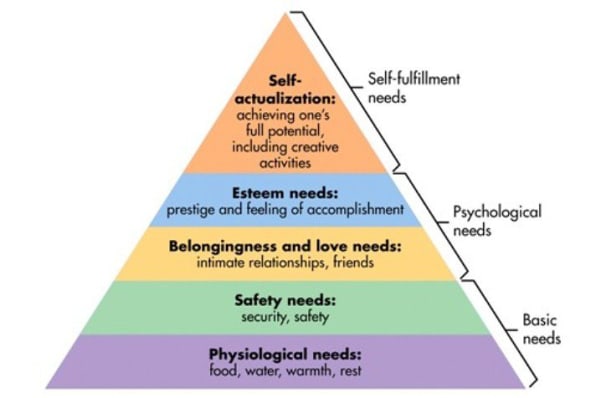
The three steps in between the physiological needs and the fulfillment needs are where marketing most direct applies.
- Safety
- Belonging
- Esteem
In Maslow'southward pyramid, the descriptions for these needs don't exactly have a marketing perspective to them, so it requires a little creativity to meet how you can tailor your message to fit these needs. Christine Comaford, an author and adept on the subject of persuasion, has constitute safety, belonging, and esteem to have incredible value for our everyday work and our creative lives:
Without these three essential keys a person cannot perform, innovate, exist emotionally engaged, agree, or move forward … The more than we take of (these three keys) the greater the success of the visitor, the relationship, the family, the team, the individual.
Her experience has helped her hone iii phrases that are key for influence and persuasion and for creating this sense of safety, belonging, and mattering that we all need. Here they are:
- "What if." This phrase removes ego from the discussion and creates a safe environment for curiosity and brainstorming.
- "I need your help." This flips the roles of dominant and subordinate, engaging the other person and providing a transfer of power.
- "Would it be helpful if." This phrase shifts the focus from the trouble to the solution.
- Hither'south an example from Nick Eubanks of SEO Nick who uses the phrase "I Need Your Help" directly in the field of study line of an e-mail. (Come to think of it, each of these three would be fun to try as email discipline lines.)

How to win friends and influence your audience
When you talk virtually influencing people, our ears perk up at Buffer. Our visitor culture and values are based on a book by Dale Carnegie called How to Win Friends and Influence People. The advice from Christine Comaford above has that familiar band of Carnegie to it. Remove your ego. Default to happiness and positivity. Exist welcoming to others.
In a lot of ways, a word on persuasion and influence could begin and terminate with Carnegie'southward book. Here is just a segment of the book'southward table of contents, filled with ideas on kindness, generosity, and partnership. (Carnegie would probably dislike that I'grand having yous read merely the table of contents–he brash readers to read each affiliate of his book multiple times.)
Win people to your style of thinking
- The only manner to get the best of an argument is to avert it.
- Show respect for the other person's opinions. Never say, "You're wrong."
- If you are wrong, admit it speedily and emphatically.
- Begin in a friendly way.
- Get the other person proverb "yes, yeah" immediately.
- Let the other person do a smashing deal of the talking.
- Allow the other person feel that the idea is his or hers.
- Try honestly to see things from the other person's point of view.
- Exist sympathetic with the other person'due south ideas and desires.
- Entreatment to the nobler motives.
- Dramatize your ideas.
- Throw downwards a challenge.
Isn't that great stuff?
We aim to include equally many Carnegie principles as we can in the manner that we communicate in emails, in comments, and of form on social media. Here are some examples from Twitter of how our Happiness Heroes practice friendliness, sympathy, and seeing things from someone else's perspective.
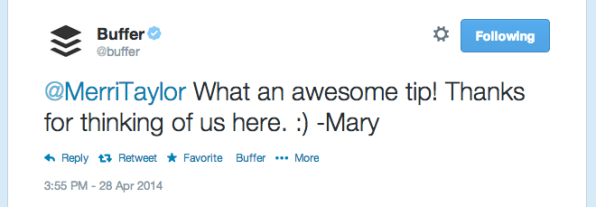
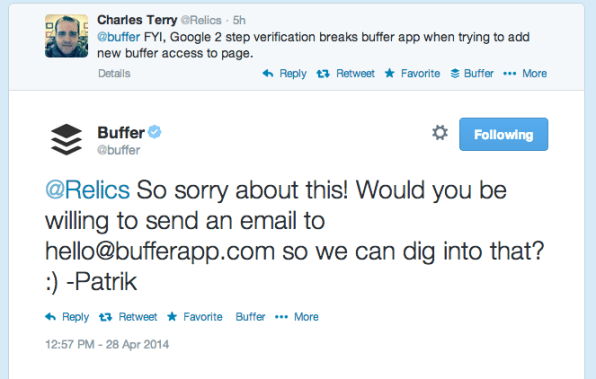
We're non the but ones who love Carnegie's volume, either. An article on Copyblogger by Andrew Schrage and Brian Spero bankrupt down the specific ways that yous can abound an audience and market your content based on Carnegie's principles. The full article contains 10 tips. Hither are 2 of my favorites:
Avert misleading headlines. A staple of Carnegie's proven methods involves recognizing the importance of others. Likewise ofttimes we forget this and care for online audiences equally hands manipulated rubes.
Instead of writing clickbait headlines that aim to coerce, it's better to practice clickable headlines that work for more virtuous reasons. Digg.com aggregates the top stories from the spider web and delivers them with headlines that are informative and clever without being manipulative.

The 2d Carnegie tip from Copyblogger goes similar this:
Salvage people money. In "How to Win Friends," we learn the importance of talking most what people desire and showing them how to become information technology.
In other words, talk about benefits instead of features.
Hither is a screengrab from the landing page of Corking.io, an analytics service for developers. Instead of explaining the features of the product–the APIs and the SDKS–Not bad talks about benefits.

While not equally overt as the assay on Copyblogger, Minda Zeltin, president of American Society of Journalists and Authors, wrote on Inc.com about her ain experiences with persuasion and influence, referencing indirectly a lot of the attitudes expressed by Carnegie.
Here are a few specific examples that Zeltin cites that deal directly with how you speak to others:

Michael Hyatt nails these elements of persuasive speech in his communication with e-mail subscribers. In addition to a few emails I've received apologizing for broken links or other mistakes, Hyatt is also so kind and generous in the manner he approaches his conversations. Here is an email that includes both a big thank you and some praise.
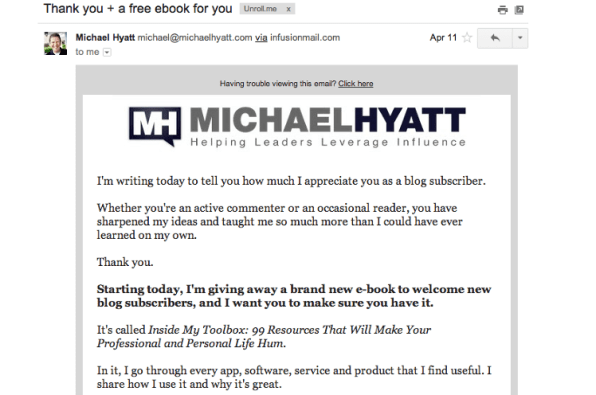
The persuasion slide: How an influential nudge leads to conversion
Here'due south a fun fashion to wait at persuasion: as a playground slide.
The thought comes from Roger Dooley of the blog Neuromarketing who uses the variables of a person on a slide to show how unlike factors touch on the outcome of influence. Here's the graphic he created to explicate the idea:
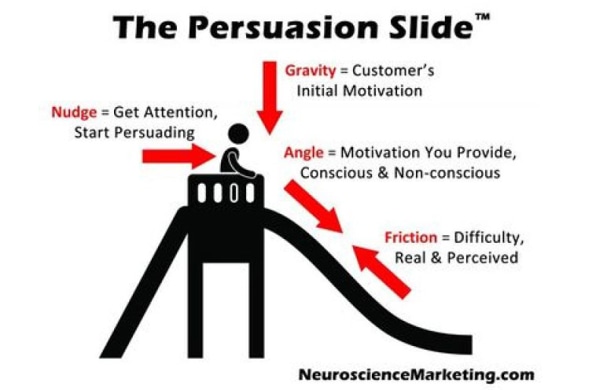
Essentially, hither's how information technology works:
You give a customer a nudge (a tweet, a blog post, a telephone call, an ad).
Gravity, that customer's internal motivations, help movement the customer downwards the slide.
Additional motivation that you provide (the bending of the slide) tin serve to raise the gravity. If a customer has low internal motivation, it volition take a steeper bending to get him or her downwardly the slide.
Friction, seen here equally the difficulty (real and perceived) in converting, causes the slide to slow down to varying degrees.
The nudge could be most anything persuasive, for example a couple of psychological theories that we outlined to a higher place. Amplification could hateful that the customer is further cementing his values and attitudes as he propels down the slide. Social proof could exist a stronger button down the slide, resulting in a faster conversion.
Robert Cialdini's six principles of persuasion
Shane Parrish of Farnam Street reads a lot of books–upwards to 14 each month–so it means something when he picks Robert Cialdini's Influence: The Psychology of Persuasion as one of the most important books he's read. In the volume, Cialdini outlines half-dozen principles of persuasion, most of which will probable sound a bit familiar based on our previous discussion on psychology.
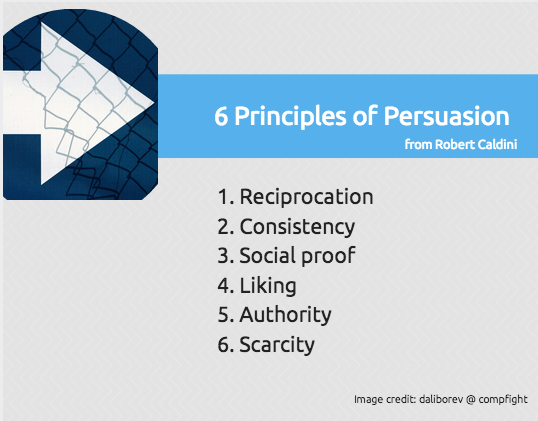
Do any of those sound familiar? Put another way, Cialdini's listing could look like this:
- Reciprocation, i.e. Reciprocity Norm
- Consistency, i.due east. Amplification Hypothesis
- Social proof, i.e. Social Influence
- Liking, i.e. Social Influence (again)
- Authority, i.e. Yale Mental attitude Alter Arroyo
- Scarcity, i.e. Scarcity Principle
One of the common threads from Cialdini's list is that of social. The principles of liking, authority, and social proof all deal with relationships with others: We are persuaded by those we similar, past those whom we deem to be authority figures, and past the general population. Here are a few unique applications of these, every bit told by Cialdini and Parrish:
Liking
One way people exploit this is to notice ways to make themselves like you. Do you lot like golf? Me too. Do you lot like football game? Me also. Although often these are 18-carat, sometimes they're not.
Liking is like plenty to consistency that information technology bears pointing out the difference here. Someone might say, "Do you like having more visitors to your weblog?" They aren't necessarily looking for a connexion with you (as in Liking) but rather they're seeking Consistency. Of form you'll say yes, and in theory, you lot'll accept a harder time backing off that argument when you are pitched a product or service afterwards.
Authority
Something equally unproblematic as informing your audience of your credentials earlier you lot speak, for example, increases the odds you will persuade the audience.
Noah Kagan does this for the each guest post he publishes at OK Dork. He writes a quick intro on how he made the connection with the guest writer and all the amazing credentials the invitee author has.
Social proof
People volition more likely say yeah when they see other people doing information technology also. Social poof is not all bad. It's one of the main ways we larn in life.
Basecamp has a bully example of social proof on their website, showing the wide multifariousness of respected clients that use the product—and doing so in a fun, approachable mode.
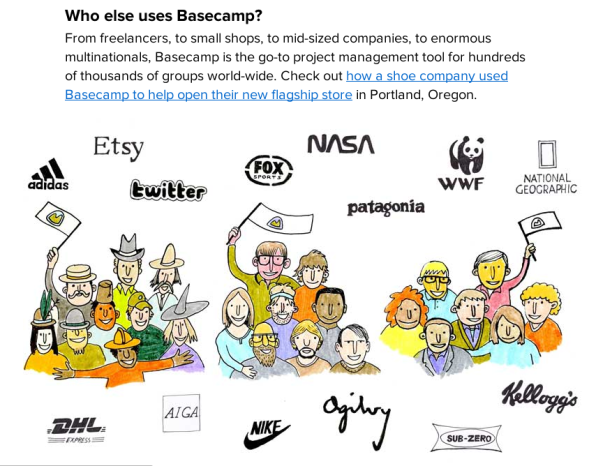
Ii others that are worth pointing out are consistency and scarcity.
Personally, consistency is the one I find myself about susceptible to, and I place a lot with how Parrish describes the effect: "If you lot ask people to country their priorities and goals and then marshal your proposals with that in mind, you make it harder for people to say no." really hit habitation for me. Parrish connects this to the Ikea upshot, the mode you beloved your IKEA furniture because yous're invested in information technology from building information technology yourself.
As for scarcity, Visual Website Optimizer wrote an extensive post on all the different ways you can use scarcity to increment eastward-commerce sales. Accept you lot noticed that Amazon tells people in that location are only a certain number of products left? That's scarcity at play.
Hooks: Psychology in activeness in your copy and on your site
Throughout this post, I've tried to highlight some good examples of the psychology of persuasion as it exists on the web. It's great to know the theories; it'south also helpful to meet the techniques and applications. Bushra Azhar, a persuasion strategist and founder of The Persuasion Revolution, wrote down several of her techniques that she has used to neat effect in creating persuasive copy. Hither is a sampling of the means she's used to invoke positive emotions in website visitors.
Disrupt then reframe
Y'all tin can disrupt routine idea processes past mixing around the words and visuals that a user is used to seeing then reframing your pitch while they're still figuring out the disruption. Researchers tested this technique by pitching a product equally costing $3.00 versus 300 pennies; the penny pitch was the articulate winner.
A unique implementation of this is on TeuxDeux's pricing page. Instead of standard names for their pricing tiers, TeuxDeux went with a disruption technique with the copy and so reframed the pitch with the pricing info beneath.

The key to practiced storytelling
We mentioned above the theory about ultimate words, and nosotros've written recently about the power of storytelling in your content. Azhar points out that a step beyond storytelling is making sure that you lot are telling the right story. She references the book Made to Stick, which talks about the three stickiest and most memorable story plots.
i. The Claiming Plot: A story of the underdog, rags to riches or sheer willpower triumphing over adversity
2. The Connection Plot: A story almost people who develop a relationship that bridges a gap, whether racial, class, indigenous, religious, demographic or otherwise; think of the film The Blind Side
iii. The Creativity Plot: A story that involves someone making a mental breakthrough, solving a long-standing puzzle or attacking a problem in an innovative way
The Groove HQ blog regularly starts blog posts with a storytelling chemical element, often using variations on The Creativity Plot to claw readers and give that nudge down the persuasion slide.

Opportunities for persuasion
By now, I'm sure you tin can see just how much psychology is involved in the art of persuasion. By extension, you can also see psychology in the social media messages and marketing tactics of some influential brands.
When it comes to applying the principles of persuasive psychology, here are a few places you can first:
- Your calls-to-action
- Your headlines
- Your tweets and updates
- Your emails
- Your production descriptions
Almost anywhere that you have words or visuals–anywhere that you lot create or manage content–you tin can turn into an opportunity for persuasion.
What places on your website and in your social media marketing take you lot used psychological persuasion? Which of these theories practise you recognize, either in your ain marketing or in the marketing of others? I'd love to take this conversation further in the comments.
This commodity originally appeared in Buffer and is reprinted with permission.
andersondisteling.blogspot.com
Source: https://www.fastcompany.com/3030173/how-to-use-10-psychological-theories-to-persuade-people
Post a Comment for "How to Know Psychology Is for You"